#reverse engineering testing solutions
Explore tagged Tumblr posts
Text
Unveiling the Power of Reverse Engineering Testing Services
In the dynamic landscape of software development, staying ahead of the curve is crucial. One key strategy gaining traction is the utilization of Reverse Engineering Testing Services. This innovative approach involves dissecting and understanding existing software systems to enhance their functionality, security, and overall performance.
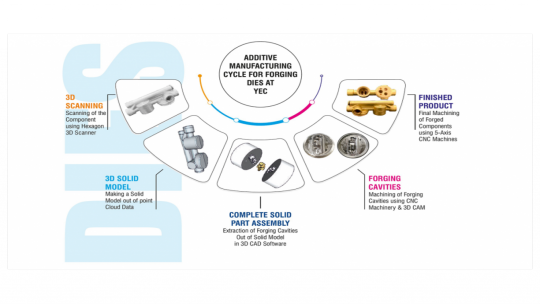
Reverse engineering testing services are not just about breaking down code; they're a strategic tool to uncover the intricacies of complex applications. By deconstructing software, developers gain insights into its structure, enabling them to identify vulnerabilities, enhance functionality, and streamline performance.
One primary advantage of reverse engineering testing is its ability to unveil hidden features or diagnose issues that may not be apparent through conventional testing methods. This process helps developers create more robust and resilient software by understanding the underlying architecture.
Moreover, reverse engineering testing services play a pivotal role in ensuring compliance with industry standards and regulations. By dissecting software components, organizations can identify potential security loopholes and rectify them before they become exploitable vulnerabilities.
In a nutshell, the power of reverse engineering testing services lies in their ability to unravel the mysteries of existing software, paving the way for innovation, security, and improved performance. As the software development landscape evolves, embracing this approach becomes increasingly essential for organizations aiming to stay competitive and resilient in the digital realm.
#reverse engineering testing services#3d scanning reverse engineering services#3d reverse engineering services#3d scanning reverse engineering testing services#3d reverse engineering testing services#reverse engineering solutions#reverse engineering testing solutions#3d reverse engineering
1 note
·
View note
Text
"Canadian scientists have developed a blood test and portable device that can determine the onset of sepsis faster and more accurately than existing methods.
Published today [May 27, 2025] in Nature Communications, the test is more than 90 per cent accurate at identifying those at high risk of developing sepsis and represents a major milestone in the way doctors will evaluate and treat sepsis.
“Sepsis accounts for roughly 20 per cent of all global deaths,” said lead author Dr. Claudia dos Santos, a critical care physician and scientist at St. Michael’s Hospital. “Our test could be a powerful game changer, allowing physicians to quickly identify and treat patients before they begin to rapidly deteriorate.”
Sepsis is the body’s extreme reaction to an infection, causing the immune system to start attacking one’s own organs and tissues. It can lead to organ failure and death if not treated quickly. Predicting sepsis is difficult: early symptoms are non-specific, and current tests can take up to 18 hours and require specialized labs. This delay before treatment increases the chance of death by nearly eight per cent per hour.
[Note: The up to 18 hour testing window for sepsis is a huge cause of sepsis-related mortality, because septic shock can kill in as little as 12 hours, long before the tests are even done.]
[Analytical] AI helps predict sepsis
Examining blood samples from more than 3,000 hospital patients with suspected sepsis, researchers from UBC and Sepset, a UBC spin-off biotechnology company, used machine learning to identify a six-gene expression signature “Sepset” that predicted sepsis nine times out of 10, and well before a formal diagnosis. With 248 additional blood samples using RT-PCR, (Reverse Transcription Polymerase Chain Reaction), a common hospital laboratory technique, the test was 94 per cent accurate in detecting early-stage sepsis in patients whose condition was about to worsen.
“This demonstrates the immense value of AI in analyzing extremely complex data to identify the important genes for predicting sepsis and writing an algorithm that predicts sepsis risk with high accuracy,” said co-author Dr. Bob Hancock, UBC professor of microbiology and immunology and CEO of Sepset.
Bringing the test to point of care
To bring the test closer to the bedside, the National Research Council of Canada (NRC) developed a portable device they called PowerBlade that uses a drop of blood and an automated sequence of steps to efficiently detect sepsis. Tested with 30 patients, the device was 92 per cent accurate in identifying patients at high risk of sepsis and 89 per cent accurate in ruling out those not at risk.
“PowerBlade delivered results in under three hours. Such a device can make treatment possible wherever a patient may be, including in the emergency room or remote health care units,” said Dr. Hancock.
“By combining cutting-edge microfluidic research with interdisciplinary collaboration across engineering, biology, and medicine, the Centre for Research and Applications in Fluidic Technologies (CRAFT) enables rapid, portable, and accessible testing solutions,” said co-author Dr. Teodor Veres, of the NRC’s Medical Devices Research Centre and CRAFT co-director. CRAFT, a joint venture between the University of Toronto, Unity Health Toronto and the NRC, accelerates the development of innovative devices that can bring high-quality diagnostics to the point of care.
Dr. Hancock’s team, including UBC research associate and co-author Dr. Evan Haney, has also started commercial development of the Sepset signature. “These tests detect the early warnings of sepsis, allowing physicians to act quickly to treat the patient, rather than waiting until the damage is done,” said Dr. Haney."
-via University of British Columbia, May 27, 2025
#public health#medical news#sepsis#cw death#healthcare#medicine#medical care#ai#canada#north america#artificial intelligence#genetics#good news#hope
831 notes
·
View notes
Text
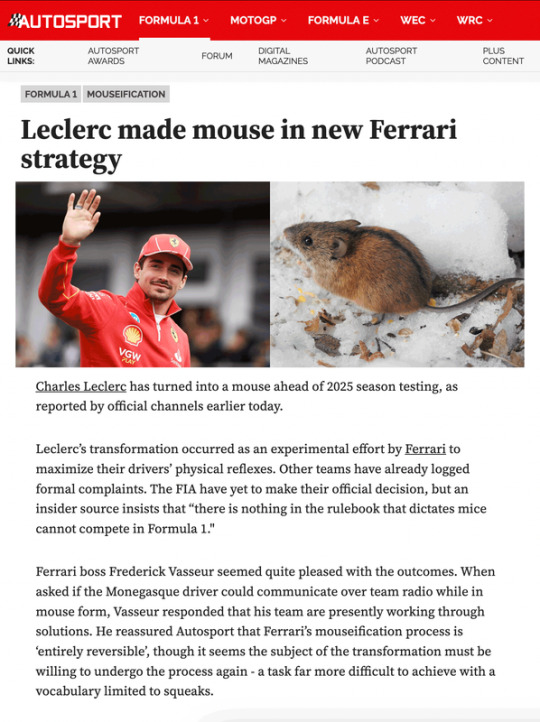
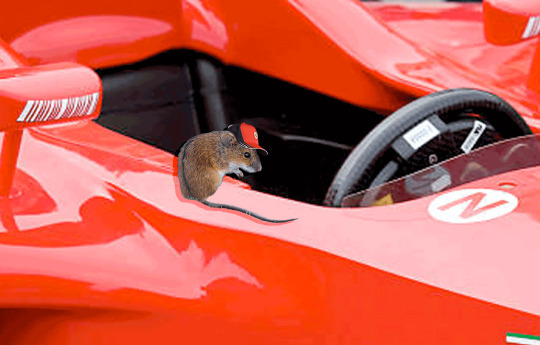



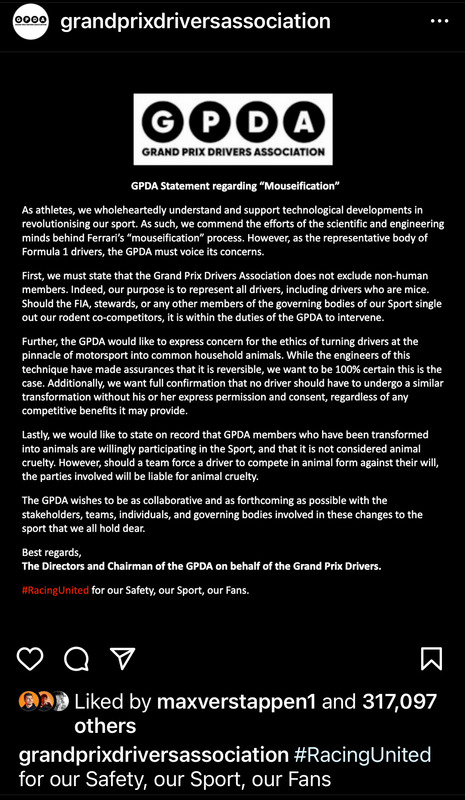


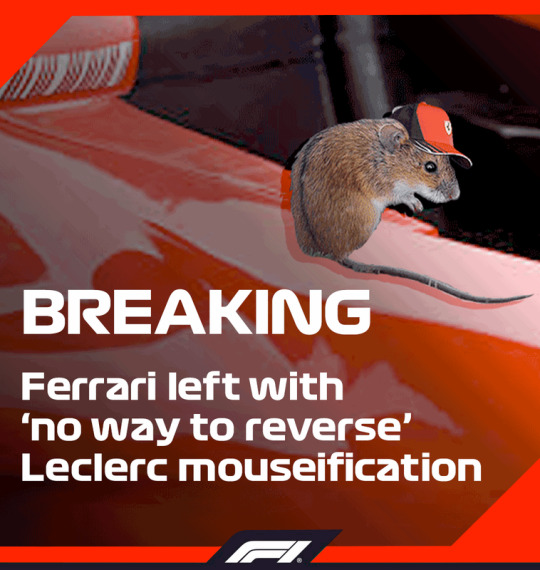

To our most dearest most beloved elle @gayferrari ✨
Happy birth-week from carp @antspaul and myself. Please enjoy this wonderful and silly gift from the pair of us ❤️. We're so glad to have you in both our lives, and hope this brings you joy.
(also here on ao3)
Image ID under the cut.
[a series of 10 images describing Charles Leclerc’s journey into becoming a mouse during the 2025 Formula 1 season.
IMAGE 1:
A screenshot from Autosport’s website.
‘Leclerc made mouse in new Ferrari strategy’ followed by a banner of two images showing Leclerc in his human form and also as a striped field mouse.
The text reads:
‘Charles Leclerc has turned into a mouse ahead of 2025 season testing, as reported by official channels earlier today.
Leclerc’s transformation occurred as an experimental effort by Ferrari to maximize their drivers’ physical reflexes. Other teams have already logged formal complaints. The FIA have yet to make their official decision, but an insider source insists that “there is nothing in the rulebook that dictates mice cannot compete in Formula 1”.
Ferrari boss Frederick Vasseur seemed quite pleased with the outcomes. When asked if the Monegasque driver could communicate over team radio while in mouse form, Vasseur responded that his team are presently working through solutions. He reassured Autosport that Ferrari’s mouseification process is ‘entirely reversible’, though it seems the subject of the transformation must be willing to undergo the process again - a task far more difficult to achieve with a vocabulary limited to squeaks.’
IMAGE 2:
Charles Leclerc in mouse form, standing near the cockpit of his F1 car. He is a striped field mouse wearing a ferrari cap.
IMAGE 3:
Charles Leclerc in mouse form, standing on the head of his golden Dachshund Leo. Leo is running towards the viewer with a red chew toy in his mouth.
IMAGE 4:
Screenshot of Leclerc’s radio message during a race. The radio reads: ‘Squeak Squeak ****** Squeak’
IMAGE 5:
An advertisement of Parmesan cheese being sold by Charles’ ice cream company. Charles in his mouse form is posing by a wheel of parmesan. The word LEC in brand font is above his head.
IMAGE 6:
A screenshot from the GPDA’s instagram profile. It shows the GDPA’s statement on Charles’ mouse transformation.
The text reads:
“‘GPDA Statement regarding “Mouseification’
As athletes, we wholeheartedly understand and support technological developments in revolutionising our sport. As such, we commend the efforts of the scientific and engineering minds behind Ferrari’s “mouseification” process. However, as the representative body of Formula 1 drivers, the GPDA must voice its concerns.
First, we must state that the Grand Prix Drivers Association does not exclude non-human members. Indeed, our purpose is to represent all drivers, including drivers who are mice. Should the FIA, stewards, or any other members of the governing bodies of our Sport single out our rodent co-competitors, it is within the duties of the GPDA to intervene.
Further, the GPDA would like to express concern for the ethics of turning drivers at the pinnacle of motorsport into common household animals. While the engineers of this technique have made assurances that it is reversible, we want to be 100% certain this is the case. Additionally, we want full confirmation that no driver should have to undergo a similar transformation without his or her express permission and consent, regardless of any competitive benefits it may provide.
Lastly, we would like to state on record that GPDA members who have been transformed into animals are willingly participating in the Sport, and that it is not considered animal cruelty. However, should a team force a driver to compete in animal form against their will, the parties involved will be liable for animal cruelty.
The GPDA wishes to be as collaborative and as forthcoming as possible with the stakeholders, teams, individuals, and governing bodies involved in these changes to the sport that we all hold dear.
Best regards,
The Directors and Chairman of the GPDA on behalf of the Grand Prix Drivers.
#RacingUnited for our Safety, our Sport, our Fans.”
IMAGE 7:
A screenshot of Charles’ interview with the Athletic. The title reads: “Man or Mouse? Leclerc opens up about mouseification, cheese sponsorship, and 2025 WDC hopes”
It is followed by a graphic banner. The banner displays the Ferrari badge, Charles in his human form, and Charles in his mouse form. His mouse form is wearing a Ferrari cap, and is on a red circle background.
IMAGE 8:
A screenshot of Charles’ interview with the Athletic, containing an excerpt of it.
The text reads:
“Man or Mouse? Leclerc opens up about mouseification, cheese sponsorship, and 2025 WDC hopes”
Indeed, Leclerc has gone from success to success since the opening of the 2025 season. Within a week of claiming the top step in Melbourne, the Monegasque driver announced a new personal sponsorship and collaboration with none other than Parmigiano Reggiano — a match made in heaven, since Leclerc’s momentary mouse metamorphosis.
“It’s changed my outlook on racing,” he squeaked to his interpreter, four-time world champion Sebastian Vettel, at whose farm Leclerc has been rumoured to reside since his mouseification. “Being a mouse, it gives me more courage in the car to try things I wouldn’t be trying in previous seasons.”
This new perspective can be seen in how Leclerc carries himself, though he is only ten centimeters tall. When asked about his target for this season, he answered without hesitation: “To be world champion. This hasn’t changed. I am more certain than ever that this year it is possible.” The current points standings would not disagree. “No mouse has ever been world champion. It would mean a lot to the greater rodent community. It would mean a lot to me.”’
IMAGE 9:
A breaking news announcement from the official F1 channels. It is framed in Ferrari red. It shows Charles’ in mouse form on his car.
The text in the image reads:
‘BREAKING
Ferrari left with ‘no way to reverse’ Leclerc mouseification.
IMAGE 10:
A photo of Sebastian Vettel at the paddock. Charles Leclerc in mouse form is sitting on his shoulder, wearing a little bucket hat.
END ID]
#charles leclerc#sebastian vettel#ferrari#f1#dan.txt#elle ilysm 💕#writing the little texts was SO fun i was giggling the whole time#also shout-out carp for their excellent PS skills#my fic#mine
424 notes
·
View notes
Text
The most powerful ability exclusive to humanity in the Half Life/Portal shared universe is our ability to just throw bullshit at the wall and see what sticks. Aperture "OSHA are the devil" Science have managed to create completely safe interconnected points in space. The same company that turns people's blood into gasoline and shoves lions and humans into the same enclosed space for the vague concept of "Science". Meanwhile Black Mesa still has to use Xen as a crossing and their teleportation device requires an entire reactor with a village's worth of staff constantly maintaining it, just to end up having most of said staff abducted by onion-headed aliens. Even the resistance hasn't managed to create completely stable teleporters with a compressed Xen relay, meanwhile Aperture just went "oh dude let's shove a black hole into a non-waterproof gun" and have just created a teleportation method that just removes Xen from the equation entirely. Doesn't change the fact they bullshat so bad they basically got themselves gassed to death, but still.
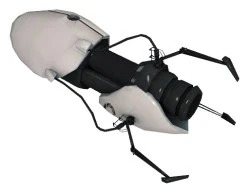

The Resistance are a good example of this too. The Combine seem to have a complete set-in-stone thought process and understanding of science which meant they didn't even begin to explore local teleportation via Xen, meanwhile a group of random human mechanics and scientists have managed to cobble together at least two semi-functional local teleporters out of scrap metal and stolen Combine tech, to the point the All-Consuming Interdimensional Empire had to straight up copy their homework. And that isn't even the only time they seem to be taking human shit to just copy the blueprints.
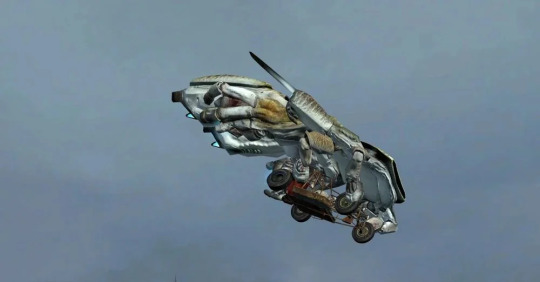
They 100% just yoinked the entire damn car out of that garage just to take a crack at reverse-engineering the Tau Cannon attached to it. Even Resistance weaponry somehow manages to rival or at least stand equal to Combine tech - and we're talking improvised crossbows that shoot superheated rods of rebar at the target compared to high-tech rifles that can discharge orbs of pure dark energy. The collapse of the entire Citadel is basically set into motion as a result of a cobbled together Rebel device placed into extremely capable hands.
The events of the Portal games are a case of extremely elaborate machinelike planning versus pure human improvisation, with Chell's entire escape in the first game involving her simply weaseling her way through small cracks that GLaDOS missed while setting up her ambushes, eventually turning her own rocket turret against her to destroy her.
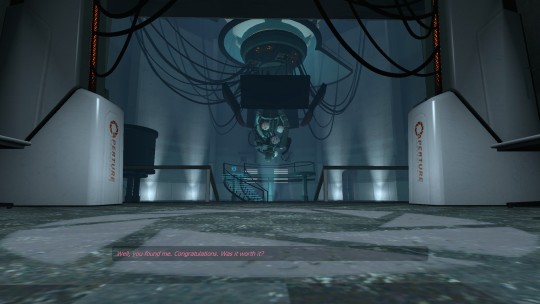
I suppose you could argue this falls flat in Portal 2 with Wheatley, but it's important to remember he's designed to be an utter idiot, so it's safe to say he wouldn't obsess over the larger picture like GLaDOS to the point where he fails to see the cracks. Yes, he's the one that breaks Chell out of the test chambers again, and yes, he's the one that came up with the sabotage plot - but it's important to note while he knows what to target in the sabotage, when we actually get there he doesn't quite know how to sabotage it, leaving Chell to figure it out on her own. She botches the Turret Quality Control Line with some minor guidance, but it's basically completely up to her to figure out how to cut off the Neurotoxin Supply. It's through her improvisation that Wheatley even manages to get into GLaDOS' chamber, tumbling through her neurotoxin vent and shattering the glass cage she trapped Chell inside of. It's through Chell's improvisation that the Core Transfer even occurs in the first place.
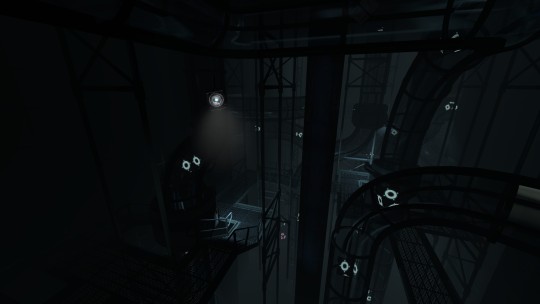
The script is flipped specifically when Wheatley takes charge, because oops - turns out a mind capable of focusing on the bigger picture might be pretty important when it comes to running an entire facility powered by it's own Reactor. Wheatley just completely zeroes in on his own personal pleasure, hacking up test chambers and the objects within them to try and figure out the easiest way to get his solution euphoria as quick as possible.
Still, something that's pretty interesting is that only Wheatley has ever managed to create a trap that's impossible to foresee and avoid, something GLaDOS has repeatedly failed to do to the point she ends up commending him. I believe this is because his way of thinking is a lot closer to Chell's compared to GLaDOS'. He puts up way more of a fight as the two run through the facility trying to get to him, seemingly improvising on the spot just like Chell has been over the course of the two games. Even his lair would be impossible to survive if it weren't for a single Conversion Gel pipe he somehow failed to notice and remove.
Whether in a laboratory deep beneath the soil or an alien tower tall enough to split the clouds, the ingenuity of even a single person is enough to topple a tower or destroy a supercomputer 3 times over.
Marc Laidlaw put what I'm trying to say into a single sentence when writing for the BreenGrub twitter account:
"The superstructure is riddled with cracks."
#portal#portal 2#half life#half life 2#hl#hl2#aperture science#black mesa#the combine#GLaDOS#Wheatley#Chell#rambling#i think this is what happens when you've been having thoughts about a game franchise like . since birth
985 notes
·
View notes
Text


Square antiprism box
Part I
(many thanks @queercus-books for finding out what that shape is called XD)
Over a year ago I saw this particular kind of box on the bookbinders fair in Leiden (NL). After having been recently reminded of them, I decided to give it a go and try to reverse engineer them from the pictures I found here (check out her other boxes, they are gorgeous!).
After staring at the original boxes for a bit, it was obvious they were not covered on the inside after gathering them. The pattern was visible in one consecutive pattern. It told me that a) the board was laminate with the patterned paper while still flat and b) the box was made from one piece, not single pieces glued together. For that the corners and edges needed to be scratched, but not cut through.

What stumped me in the beginning was what angle to pick for the walls. Naturally the base of each triangle had to be as long as the sides of the squares it connected to, but a too pointy angle at the tip resulted in long boxes that looked rather twisted than having that bulbous look I was looking for.
The solution (after some more staring and a few more paper models) was 'right angles'! Any square piece of board can be made into this box by marking out the center square and have the walls point away in right angles.

Next I cut away the parts that won't be needed (to make sure I don't cut one of the side walls off, I crossed them out). The net of polyhedrons for this box could look different than this and still give me this shape, but with the way the paper pattern is was not visibly interrupted I'm confident this is the net the Dutch bookbinder has used. (It also wastes the least material)

Now it was scratching the other lines just enough so they would bend nicely, but not get too weak to hold the structure and test assemble. Shallow cuts and test bending every now and then helps to get there (also a metal ruler to keep carving the same line)




Cutting the board half way through ended me up with those gaps though. I''m not sure how much they would show if I dressed them just like that, but I decided to not take the risk and reinforced them with a white paper just in case.


The white paper is really just a white strip of paper long enough to go all around the box and a bit wider than one of the triangles is high so I could have an overlap and reinforcement to the bottom too. Part of why I did this was also to see if covering the body would work as I thought it would. With the angled planes the strip of paper bends up and and down, but in the end it's still one straight strip of paper.
I let it dry a bit before adding another layer, this time with the patterned paper and turn in's on top and bottom. In hindsight I could have cut the turn ins to the inside at an wider angle to avoid them reaching onto the better visible part, but then. this is the first time I made this box so I take that as a lesson learned.


Now all it needs is a base and a lid and I'm done.
62 notes
·
View notes
Text
Wings of Home – Chapter Five: Echoes of Afterburners
Tom Kazansky rarely let himself drift into memory. But some days—when the ocean mist smelled like jet fuel and Maverick was humming in the kitchen—he let himself go back.
It was 1986, and the sky had just started to feel wide enough for something more than rivalry. One night, after a sparring match on the beach turned into a kiss behind the hangar, Maverick had sat him down, cheeks flushed and voice cracking.
“There’s something you need to know,” he’d said, fingers trembling against Tom’s wrist. “It’s not common... but I can carry. It’s rare. But it’s real.”
Tom remembered blinking, stunned. “You mean... you could have kids?”
“I mean I could have kids,” Maverick had said, with a shaky grin. “As in... get pregnant.”
The thought hadn’t frightened Tom. What had terrified him came later.
Years later, in their early and mid forties, after decades of hiding, running, and flying at the edge of death, Maverick had held up a pregnancy test like it was a missile warning.
“I’m pregnant.”
Tom had gone pale. “Mav... you’re almost fifty.”
“Don’t remind me.”
They’d rushed through tests, experts, specialists. The word high-risk was thrown around like flares in a dogfight. But then came the second bombshell:
“Twins,” the doctor said, smiling.
Tom laughed, full and loud and shaking. “Of course. Because one Mitchell isn’t chaotic enough.”
They’d retired not long after, the Navy closing its chapter on two of its brightest legends. They didn’t leave in shame—they left as icons.
Maverick and Goose poured themselves into their new business, Need for Speed Solutions, which quickly became the Mecca for fighter jet restoration and tech innovation. Goose handled logistics and engineering, Maverick handled flight tests and instinct. Together, they built something that kept them flying—just closer to home.
And then came the wedding
When Don’t Ask, Don’t Tell finally died in the early 2000s, Maverick didn’t waste a second. They married on the same airfield where they first met. Every surviving pilot from TOPGUN came. Rooster was best man. Goose walked Maverick down the aisle until Viper intercepted halfway.
“You’re the son I always wanted, Pete,” Viper had said, voice full of emotion. “And I’m proud of you. As proud as Duke Mitchell would’ve been.”
Maverick’s voice had caught in his throat. “Thank you, sir.”
“No more 'sir,'" Viper said with a grin. “Today, just family.”
Tom had waited at the altar, hands steady, heart wild. When Maverick reached him, the wind kicked up across the runway, a salute from the sky.
Now, with Ace and Nikola turning six, those memories lived in every corner of the house.
The twins sat side by side at the kitchen island, mapping out their party with colored pencils and a whiteboard.
“Okay,” Nikola said, tapping her stylus like a commander. “We need enough cupcakes for 60. Invite list is currently at 48, but we’ll probably have overflow from school.”
“We should get the drone obstacle course from last year,” Ace said. “But bigger. With lasers.”
“No real lasers,” Nikola added.
“Fine. Projected lasers.”
They turned to their dads, who were watching from the doorway with proud, tired eyes.
“Can we invite Professor Eddings from quantum lab?” Nikola asked.
“And my friend Jun from flight sim club?” Ace added. “He called me ‘aerodynamically reckless,’ which means we’re best friends now.”
Tom stepped forward, brushing Nikola’s hair back. “You can invite whoever you want. But just remember—your birthday’s not about how many people come.”
“It’s about family,” Maverick finished, ruffling Ace’s hair. “And being grateful.”
Nikola looked at her brother. “I’m grateful for you. Even when you reverse-engineer my robot.”
“I only did it because I wanted to improve its handshake grip,” Ace mumbled.
She smiled. “I know.”
They bumped shoulders.
Tom and Maverick stood back and watched them—their twins. Born of impossible odds. Raised in sunlight, science, and fierce love. Not just brilliant minds, but brilliant hearts. Protective. Loyal. The best parts of them both.
And as the Pacific sun began to sink over their two houses—joined by more than sand and sea—Tom leaned into Maverick.
“You know,” he said quietly, “if you’d told me in ‘86 that we’d be standing here…”
Maverick smiled. “You wouldn’t have believed me.”
“I would’ve flown faster to get here.”
Chapter one Chapter two Chapter three Chapter four Chapter six
20 notes
·
View notes
Text
Greater Plot Implications for Path of Life
Okay we're gonna go deep in spoilers this time, for more than just Path of Life far into the main story, so be warned! Time to (try to) dissect what the conversation between Mártus and Kal'tsit might have been on about. The majority of these dialogue cuts are from BP-7.

Mártus distinguishes himself as an extremely knowledgeable individual and grabs the attention of the reader by referring to Kal'tsit as Ama-10 as one of his opening lines, among other things:

Mártus continues and explains that he and the seaborn are aware of crucial things about the setting, including the fall of the Predecessors, but before that we need to talk about other things revealed in the event.
This detail was first hinted at in Babel with the Doctor's waking up, of them asking about Caerula Arbor alongside the ruined gates, establishing it as a Predecessor ruin. Throughout PoL it's established that Aegir exploded scientifically due to reverse engineering several of these ruins, including those implanted into the mantle of the world:

Within these ruins is a Feranmut, one who shares to the now-lone Mártus in this ruinous expedition the silencing of the Predecessors and everything extinguishing, describing a wasteland reminiscent of a universal heat death:

This horrifies Mártus, as it has horrified the Feranmut sharing the vision, who had since devised a plan: do anything necessary, consume everything necessary, to survive the second coming of whatever this apocalypse was. The Seaborn are an extension of this specific Feranmut's will and Mártus' actions:


Keep in mind 'Ark' for later. Kal'tsit mentions knowledge if not experience with Feranmut spawn dying outside of it's body, which is off-putting, while also mentioning Feranmuts, plural.

Unlike Kal'tsit Aegir was unaware of other Firstborn (Seaborn related Feranmut), the other three being revealed far earlier than now in IS3. These four are described as each having respective influences and control over the Seaborn and ocean, suggesting all four of them being part of the same Predecessor project, but it's difficult to determine what's relevant given IS3's alternate universe identity, so I won't dwell on it.
To try and draw some conclusions-
I want to call to mind the mysterious menu skeleton, and the fact that Rhodes Island (which is a Predecessor artifact) also ostensibly holds a whale skeleton (probably the menu skeleton) as said and escorted by Ines in Darknights Memoir:

Chapter 13 reveals the Lifebone, a mostly dead Feranmut reduced to nothing but a skeleton that's capable of maneuvering through definitely space, and potentially time. When we compare these abilities and the RI skeleton to probably the most intimidating and daunting set of lines to understand in the entire event:
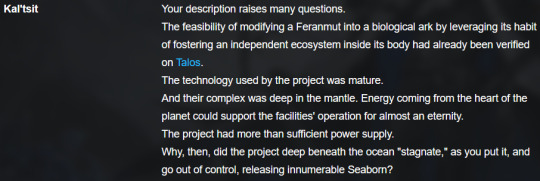
A picture begins to form in my mind that Feranmuts are, or at least can be, Predecessor biotechnological projects. The Lifebone was a naturally occurring Feranmut, not an engineered one, but its capabilities of traversing space (and maybe time) are undeniable, especially if that involves vast distances in space travel.
What I can say is that: - The Lifebone demonstrates sentience and rationality; it can be talked to and convinced, both happen in chapters 13 & 14. - The actions and thoughts of the Firstborn that Mártus talked to suggest they appear to be invested in the survival of life, at least of themselves. - By virtue of what Kal'tsit said, they do also care about their 'internal independent ecosystems,' which has been proven to be able to be co-opted and replaced by humans. - By virtue of this project existing Feranmuts are capable of things irreproducible even to the Predecessors. - Feranmuts exist outside of Terra as they were tested with on Talos
The despairing Feranmut derailed from the project, intentionally or due to the collapse of the Predecessors and oversight, and sought to evolve a solution to the impending apocalypse, simulating growth in its spawn, and acquiring nutrients for its own evolution.
I'm content that I can now read this full conversation and understand it, but this clarity unfortunately reinforces and exaggerates the mysteries of existing questions. Primarily being "What exactly happened to the Predecessors?", "What were their plans for survival, how did they involve Feranmuts and to what extent?", and "What exactly are Feranmuts?"
#arknights#path of life#spoilers#speculation#only a little bit of pepe silvia#maybe a lot#long post#arkharla
48 notes
·
View notes
Text
tech talk: ride height, road bikes, and entertainment
last week, we witnessed fabio quartararo relinquish a hard-fought race lead due to a unique type of mechanical error: the rear ride-height device of his Yamaha M1 was stuck in the low position. i was struck by the similarities of that incident to maverick viñales' DNF at sachsenring in 2022, the first real peek at the potential unreliability of rear ride-height devices.
the process is simple: the back end of the bike drops down when exiting a corner, improving acceleration and stability. lowering the bike's center of gravity reduces its chance to wheelie, meaning all that low-gear torque from the engine goes straight into the front wheel.
the ride-height device that MotoGP bikes use is, under the current rules, entirely mechanical. a sensor at the fork reads the front position as the bike corners, then starts a sort of rube goldberg machine-esque series of reactions to trigger the back to drop during corner exit.
the front ride-height devices that Ducati used briefly until they were banned in 2023 were a similar system, but were triggered by the rider instead of automatically. in this clip, you can see pecco disengage it coming out of the last corner at mugello.
when front ride-height devices were banned in 2023, it was with the support of 5 out of 6 manufacturers -- Ducati were the only ones opposing it. i'm conflicted; on one hand, ducati worked hard to develop and integrate the technology, and even if it gave them an advantage, that's just how improvement works in a machine-based sport. on the other hand, if one team can guarantee success by just pouring the most money into development, the sport becomes increasingly asymmetrical and frankly boring.
with all ride-height devices now set for elimination in 2027, i'm again split on the rationale for turning the clock back and regressing a lot of racing technology. in terms of making MotoGP more road-relevant and accurate to the average consumer, eradicating ride-height devices is supposedly an obvious solution. but consumer ride-height add-ons exist, and they're not mechanical, they're electronic! they're more reliable as well. in fact, when the ducati front ride-height device was banned, both romano albesiano of Aprilia (now Honda) and sebastian risse of KTM both raised that example.
albesiano said,

risse said,

it's the same argument that Dorna has used to justify the 2027 tech rollbacks, but in reverse: front ride-height tech wasn't road-relevant because it was behind what production motorcycles can do, not ahead.
this exposes a contradiction in Dorna's plan. if MotoGP should exist as a sport to help manufacturers test and develop technology specifically to improve production motorcycles, why eliminate tech that exists in better forms for the average consumer? why not simply mandate that ride-height devices be electronic, thus resolving the issue of unreliability and making the technology more accurate to something a normal person could buy?
Dorna has also been clear that the tech rollback is a response to negative reactions among fans and viewers, who feel that the sport has become uninteresting. i'm one of them. but i would point to World Superbike, which is significantly more road-relevant since the bikes used are (theoretically) actual road bikes: World Superbike is fucking boring. i'm sorry, it just is. and a lot of that is because the bikes are slower and more realistic, not in spite of it! now that BMW has lost its superconcessions for the current season, they're running a very stripped down machine that's on par with or worse than most others on the grid. and because of that, the only rider that can find any success on it is Toprak Razgatlioglu, who is leaving anyway.
i'm not saying Dorna should just allow teams to pour money into futuristic rocketship motorcycles that win a million championships. but if Dorna wants to make the sport more fun and more realistic, they need to make more specific, in-depth changes than just sweeping bans. an electronic ride-height system would be a great way to test that principle.
16 notes
·
View notes
Text

NSF-funded research heads to the international space station on NASA's SpaceX CRS-32 mission
ISS national lab-sponsored investigations aim to enhance drug manufacturing and develop new materials for aerospace, defense, energy, and robotics
Three investigations funded by the U.S. National Science Foundation (NSF) and sponsored by the International Space Station (ISSInternational Space Station) National Laboratory are launching on SpaceX’s 32nd Commercial Resupply Services (CRS) mission, contracted by NASANational Aeronautics and Space Administration. These experiments leverage the microgravityThe condition of perceived weightlessness created when an object is in free fall, for example when an object is in orbital motion. Microgravity alters many observable phenomena within the physical and life sciences, allowing scientists to study things in ways not possible on Earth. The International Space Station provides access to a persistent microgravity environment. environment to advance fundamental science that could lead to improved pharmaceutical manufacturing, new materials with valuable industrial applications, and the next generation of soft active materials with lifelike properties.
These projects build on a strong, multi-year collaboration between the ISS National Lab and NSF, which allocates millions of dollars to space-based projects within the fields of tissue engineering and transport phenomena, including fluid dynamics. To date, more than 30 projects funded by NSF and sponsored by the ISS National Lab have launched to the orbiting laboratory, with nearly 70 additional projects preparing for flight. Below are details about the three NSF-funded investigations launching on NASA’s SpaceX CRS-32.
Improving Medicine Manufacturing
An investigation by Rensselaer Polytechnic Institute (RPI), supported by Tec-Masters, builds on previous research to examine protein fluid flow and clumping—a problem that occurs during manufacturing of protein-based pharmaceuticals that affects the quality of the drug.
“Proteins are used to make various therapies and must be concentrated in medicines to avoid needing to administer large amounts of fluid,” says Amir Hirsa, professor of mechanical, aerospace, and nuclear engineering at RPI. “But above a certain concentration, the proteins tend to form aggregates or clump.”
On Earth, studying protein behavior is complicated by interactions between the solution and the container used to hold it. But on the ISS, researchers can use the Ring-Sheared Drop module to form liquid into a self-contained sphere held between two rings.
Hirsa and his team can use this device to study protein motion and create more accurate models of the factors that lead to clumping, especially during drug manufacturing and dispensation to patients. The team also can test computer models that predict the behavior of proteins of vastly different concentrations and types, such as hormones and antibodies. Findings from this research could help uncover ways to avoid or reverse protein clumping, which would have a significant impact on the pharmaceutical industry.
“Another very important aspect of this work is making this data, which is so difficult to get, available to other scientists through open data repositories,” says Joe Adam, a research scientist at RPI. “Other scientists may see something even more interesting than we do.”
Developing New Materials
An investigation from the University of Alabama at Birmingham, supported by Leidos, will examine the formation of ceramic composites, which have valuable applications in several industries, including aerospace, defense, and energy. The study focuses on polymer-derived titanium carbide and silicon carbide composites that have electrical conductivity, are stable at high temperature, can be made into almost any shape and size, and are lightweight yet strong.
“These materials can be used in different extreme conditions, such as high temperatures and highly acidic or oxidative environments, where other materials become unstable or cannot survive,” says Kathy Lu, a professor in the Department of Mechanical and Materials Engineering.
Studying these composites in microgravity could reveal unique behaviors that cannot be replicated on Earth. Findings from this research could inform new techniques for ground- and space-based manufacturing of materials with specific properties for applications such as heat exchangers, electric systems, energy storage, electrodes, and microsystems.
“Nobody has studied microgravity’s effects on these ceramics, and the results could be helpful for the broader family of ceramics and other possible additives, such as fibers and nanoscale materials,” Lu says.
Studying Active Matter
A research team at the University of California, Santa Barbara (UCSB) will leverage microgravity to study active matter—microscopic particles that use energy to produce motion—and its effects on the separation of non-mixable liquids. These liquids, such as oil and water, separate into concentrated droplets of one substance dispersed in the other, a phenomenon known as active liquid-liquid phase separation (LLPS). This investigation, supported by Redwire Space Technologies, seeks a better understanding of active LLPS, which plays a key role in physics, materials science, engineering, and biology.
“Active fluids are made of billions of small molecular motors that push and pull on each other and generate a turbulent flow, like a windy day stirs the water on a beach,” says UCSB professor Zvonimir Dogic. “A long-term goal is using active matter in microfluidic devices to stir and control the separation of two substances. We’re trying to create simplified systems that start to mimic biology.”
Active LLPS could be used to create materials with lifelike properties, such as the ability to move, change shape, and self-repair, that could be used to develop more lifelike robotics.
SpaceX CRS-32 is scheduled to launch no earlier than April 21, 2025, at 4:15 a.m., from Launch Complex 39A at NASA’s Kennedy Space Center in Florida.
IMAGE: Left: A drop of protein solution less than two and a half centimeters in diameter formed in the RSD onboard the International Space Station. Right: An image showing a computed Newtonian flow diagram for the drop. Credit J. Adam
2 notes
·
View notes
Text
Progress Log 40
A good morning to you all! I hope you've slept well, invigorated and ready to face the day.
I have stayed up into the long hours of the morning, meticulously initiating the first - and perhaps the most complex - phase of my next project. The Doctor had the right idea, of course, with animals and machines. But I’m going about it the other way around.
… oh, I can indulge in a bit of bragging! I’m quite pleased with the solution I’ve developed for this concept. I will give you all a little biology lesson.
In osteology, there are cells that are responsible for the growth of bones: osteoblasts and osteoclasts. Bones do not grow the way that other tissues in the body do: instead of simply replicating, osteoclasts work to dissolve and break down the material, while osteoblasts rebuild and remodel them. Over time, almost a hundred percent of your skeleton will be refreshed with new cells.
Now, imagine if you will, a metal that could replicate itself. By working on a microscopic level, one in theory could craft an artificial batch of osteoclasts and osteoblasts. These could then be integrated into a subject’s skeletal system, upon which the conversion would take place. One would even have total control over the speed of the process, the density to completion, or even to specify certain areas of effect.
If only such a replicating metal existed! And if only I had access to blueprints, construction, and even a small sample on hand!
Serendipitous indeed. It has taken a little bit of reverse engineering and a dash of creativity, along with cloning samples for testing, as the last thing I want is to install genetically modified cells on my subjects proper. It would be a waste to destroy something so valuable by taking pointless chances, but through careful application, my subjects have taken to it quite well. It has zero recovery period to account for, and I can continue development while the process is underway.
I suppose that Metal Virus was useful for something, after all.
Sincerely yours,
⭐️ Doctor Starline
10 notes
·
View notes
Text
Once the unit system and part dimensions are determined during the reverse engineering services process, the next step is to plan out the design for 3D metal printing. Complex-shaped products require a complete understanding of the object, especially if it is part of an assembly. Critical areas of the part application must be checked to ensure that the functionality of the part does not disrupt the interrelationship between the various parts.
#reverse engineering testing services#3d scanning reverse engineering services#3d reverse engineering services#3d scanning reverse engineering testing services#3d reverse engineering testing services#reverse engineering solutions#reverse engineering testing solutions
0 notes
Text


Topics: health care, monopoly
In a recent article for Tikkun, Dr. Arnold Relman argued that the versions of health care reform currently proposed by “progressives” all primarily involve financing health care and expanding coverage to the uninsured rather than addressing the way current models of service delivery make it so expensive. Editing out all the pro forma tut-tutting of “private markets,” the substance that’s left is considerable:
What are those inflationary forces? . . . [M]ost important among them are the incentives in the payment and organization of medical care that cause physicians, hospitals and other medical care facilities to focus at least as much on income and profit as on meeting the needs of patients. . . . The incentives in such a system reward and stimulate the delivery of more services. That is why medical expenditures in the U.S. are so much higher than in any other country, and are rising more rapidly. . . . Physicians, who supply the services, control most of the decisions to use medical resources. . . . The economic incentives in the medical market are attracting the great majority of physicians into specialty practice, and these incentives, combined with the continued introduction of new and more expensive technology, are a major factor in causing inflation of medical expenditures. Physicians and ambulatory care and diagnostic facilities are largely paid on a piecework basis for each item of service provided.
As a health care worker, I have personally witnessed this kind of mutual log-rolling between specialists and the never-ending addition of tests to the bill without any explanation to the patient. The patient simply lies in bed and watches an endless parade of unknown doctors poking their heads in the door for a microsecond, along with an endless series of lab techs drawing body fluids for one test after another that’s “been ordered,” with no further explanation. The post-discharge avalanche of bills includes duns from two or three dozen doctors, most of whom the patient couldn’t pick out of a police lineup. It’s the same kind of quid pro quo that takes place in academia, with professors assigning each other’s (extremely expensive and copyrighted) texts and systematically citing each other’s works in order to game their stats in the Social Sciences Citation Index. (I was also a grad assistant once.) You might also consider Dilbert creator Scott Adams’s account of what happens when you pay programmers for the number of bugs they fix.
One solution to this particular problem is to have a one-to-one relationship between the patient and a general practitioner on retainer. That’s how the old “lodge practice” worked. (See David Beito’s “Lodge Doctors and the Poor,” The Freeman, May 1994).
But that’s illegal, you know. In New York City, John Muney recently introduced an updated version of lodge practice: the AMG Medical Group, which for a monthly premium of $79 and a flat office fee of $10 per visit provides a wide range of services (limited to what its own practitioners can perform in-house). But because AMG is a fixed-rate plan and doesn’t charge more for “unplanned procedures,” the New York Department of Insurance considers it an unlicensed insurance policy. Muney may agree, unwillingly, to a settlement arranged by his lawyer in which he charges more for unplanned procedures like treatment for a sudden ear infection. So the State is forcing a modern-day lodge practitioner to charge more, thereby keeping the medical and insurance cartels happy—all in the name of “protecting the public.” How’s that for irony?
Regarding expensive machinery, I wonder how much of the cost is embedded rent on patents or regulatorily mandated overhead. I’ll bet if you removed all the legal barriers that prevent a bunch of open-source hardware hackers from reverse-engineering a homebrew version of it, you could get an MRI machine with a twentyfold reduction in cost. I know that’s the case in an area I’m more familiar with: micromanufacturing technology. For example, the RepRap—a homebrew, open-source 3-D printer—costs roughly $500 in materials to make, compared to tens of thousands for proprietary commercial versions.
More generally, the system is racked by artificial scarcity, as editor Sheldon Richman observed in an interview a few months back. For example, licensing systems limit the number of practitioners and arbitrarily impose levels of educational overhead beyond the requirements of the procedures actually being performed.
Libertarians sometimes—and rightly—use “grocery insurance” as an analogy to explain medical price inflation: If there were such a thing as grocery insurance, with low deductibles, to provide third-party payments at the checkout register, people would be buying a lot more rib-eye and porterhouse steaks and a lot less hamburger.
The problem is we’ve got a regulatory system that outlaws hamburger and compels you to buy porterhouse if you’re going to buy anything at all. It’s a multiple-tier finance system with one tier of service. Dental hygienists can’t set up independent teeth-cleaning practices in most states, and nurse-practitioners are required to operate under a physician’s “supervision” (when he’s out golfing). No matter how simple and straightforward the procedure, you can’t hire someone who’s adequately trained just to perform the service you need; you’ve got to pay amortization on a full med school education and residency.
Drug patents have the same effect, increasing the cost per pill by up to 2,000 percent. They also have a perverse effect on drug development, diverting R&D money primarily into developing “me, too” drugs that tweak the formulas of drugs whose patents are about to expire just enough to allow repatenting. Drug-company propaganda about high R&D costs, as a justification for patents to recoup capital outlays, is highly misleading. A major part of the basic research for identifying therapeutic pathways is done in small biotech startups, or at taxpayer expense in university laboratories, and then bought up by big drug companies. The main expense of the drug companies is the FDA-imposed testing regimen—and most of that is not to test the version actually marketed, but to secure patent lockdown on other possible variants of the marketed version. In other words, gaming the patent system grossly inflates R&D spending.
The prescription medicine system, along with state licensing of pharmacists and Drug Enforcement Administration licensing of pharmacies, is another severe restraint on competition. At the local natural-foods cooperative I can buy foods in bulk, at a generic commodity price; even organic flour, sugar, and other items are usually cheaper than the name-brand conventional equivalent at the supermarket. Such food cooperatives have their origins in the food-buying clubs of the 1970s, which applied the principle of bulk purchasing. The pharmaceutical licensing system obviously prohibits such bulk purchasing (unless you can get a licensed pharmacist to cooperate).
I work with a nurse from a farming background who frequently buys veterinary-grade drugs to treat her family for common illnesses without paying either Big Pharma’s markup or the price of an office visit. Veterinary supply catalogs are also quite popular in the homesteading and survivalist movements, as I understand. Two years ago I had a bad case of poison ivy and made an expensive office visit to get a prescription for prednisone. The next year the poison ivy came back; I’d been weeding the same area on the edge of my garden and had exactly the same symptoms as before. But the doctor’s office refused to give me a new prescription without my first coming in for an office visit, at full price—for my own safety, of course. So I ordered prednisone from a foreign online pharmacy and got enough of the drug for half a dozen bouts of poison ivy—all for less money than that office visit would have cost me.
Of course people who resort to these kinds of measures are putting themselves at serious risk of harassment from law enforcement. But until 1914, as Sheldon Richman pointed out (“The Right to Self-Treatment,” Freedom Daily, January 1995), “adult citizens could enter a pharmacy and buy any drug they wished, from headache powders to opium.”
The main impetus to creating the licensing systems on which artificial scarcity depends came from the medical profession early in the twentieth century. As described by Richman:
Accreditation of medical schools regulated how many doctors would graduate each year. Licensing similarly metered the number of practitioners and prohibited competitors, such as nurses and paramedics, from performing services they were perfectly capable of performing. Finally, prescription laws guaranteed that people would have to see a doctor to obtain medicines they had previously been able to get on their own.
The medical licensing cartels were also the primary force behind the move to shut down lodge practice, mentioned above.
In the case of all these forms of artificial scarcity, the government creates a “honey pot” by making some forms of practice artificially lucrative. It’s only natural, under those circumstances, that health care business models gravitate to where the money is.
Health care is a classic example of what Ivan Illich, in Tools for Conviviality, called a “radical monopoly.” State-sponsored crowding out makes other, cheaper (but often more appropriate) forms of treatment less usable, and renders cheaper (but adequate) treatments artificially scarce. Artificially centralized, high-tech, and skill-intensive ways of doing things make it harder for ordinary people to translate their skills and knowledge into use-value. The State’s regulations put an artificial floor beneath overhead cost, so that there’s a markup of several hundred percent to do anything; decent, comfortable poverty becomes impossible.
A good analogy is subsidies to freeways and urban sprawl, which make our feet less usable and raise living expenses by enforcing artificial dependence on cars. Local building codes primarily reflect the influence of building contractors, so competition from low-cost unconventional techniques (T-slot and other modular designs, vernacular materials like bales and papercrete, and so on) is artificially locked out of the market. Charles Johnson described the way governments erect barriers to people meeting their own needs and make comfortable subsistence artificially costly, in the specific case of homelessness, in “Scratching By: How the Government Creates Poverty as We Know It” (The Freeman, December 2007).
The major proposals for health care “reform” that went before Congress would do little or nothing to address the institutional sources of high cost. As Jesse Walker argued at Reason.com, a 100 percent single-payer system, far from being a “radical” solution,
would still accept the institutional premises of the present medical system. Consider the typical American health care transaction. On one side of the exchange you’ll have one of an artificially limited number of providers, many of them concentrated in those enormous, faceless institutions called hospitals. On the other side, making the purchase, is not a patient but one of those enormous, faceless institutions called insurers. The insurers, some of which are actual arms of the government and some of which merely owe their customers to the government’s tax incentives and shape their coverage to fit the government’s mandates, are expected to pay all or a share of even routine medical expenses. The result is higher costs, less competition, less transparency, and, in general, a system where the consumer gets about as much autonomy and respect as the stethoscope. Radical reform would restore power to the patient. Instead, the issue on the table is whether the behemoths we answer to will be purely public or public-private partnerships. [“Obama is No Radical,” September 30, 2009]
I’m a strong advocate of cooperative models of health care finance, like the Ithaca Health Alliance (created by the same people, including Paul Glover, who created the Ithaca Hours local currency system), or the friendly societies and mutuals of the nineteenth century described by writers like Pyotr Kropotkin and E. P. Thompson. But far more important than reforming finance is reforming the way delivery of service is organized.
Consider the libertarian alternatives that might exist. A neighborhood cooperative clinic might keep a doctor of family medicine or a nurse practitioner on retainer, along the lines of the lodge-practice system. The doctor might have his med school debt and his malpractice premiums assumed by the clinic in return for accepting a reasonable upper middle-class salary.
As an alternative to arbitrarily inflated educational mandates, on the other hand, there might be many competing tiers of professional training depending on the patient’s needs and ability to pay. There might be a free-market equivalent of the Chinese “barefoot doctors.” Such practitioners might attend school for a year and learn enough to identify and treat common infectious diseases, simple traumas, and so on. For example, the “barefoot doctor” at the neighborhood cooperative clinic might listen to your chest, do a sputum culture, and give you a round of Zithro for your pneumonia; he might stitch up a laceration or set a simple fracture. His training would include recognizing cases that were clearly beyond his competence and calling in a doctor for backup when necessary. He might provide most services at the cooperative clinic, with several clinics keeping a common M.D. on retainer for more serious cases. He would be certified by a professional association or guild of his choice, chosen from among competing guilds based on its market reputation for enforcing high standards. (That’s how competing kosher certification bodies work today, without any government-defined standards). Such voluntary licensing bodies, unlike state licensing boards, would face competition—and hence, unlike state boards, would have a strong market incentive to police their memberships in order to maintain a reputation for quality.
The clinic would use generic medicines (of course, since that’s all that would exist in a free market). Since local juries or arbitration bodies would likely take a much more common-sense view of the standards for reasonable care, there would be far less pressure for expensive CYA testing and far lower malpractice premiums.
Basic care could be financed by monthly membership dues, with additional catastrophic-care insurance (cheap and with a high deductible) available to those who wanted it. The monthly dues might be as cheap as or even cheaper than Dr. Muney’s. It would be a no-frills, bare-bones system, true enough—but to the 40 million or so people who are currently uninsured, it would be a pretty damned good deal.
#health care#monopoly#us healthcare#us politics#healthcare#medicine#science#kevin karson#anarchism#anarchy#anarchist society#practical anarchy#practical anarchism#resistance#autonomy#revolution#communism#anti capitalist#anti capitalism#late stage capitalism#daily posts#libraries#leftism#social issues#anarchy works#anarchist library#survival#freedom
2 notes
·
View notes
Text
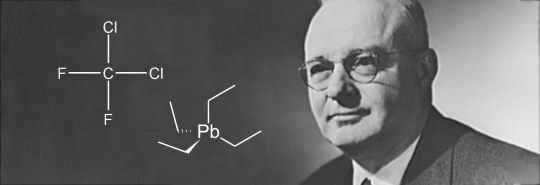
I feel like we don't really talk about Thomas Midgely Jr.
The man who is single-handedly responsible for creating the 2 most destructive chemicals of the 20 century. Chemicals that should have never been created.
So I am here to change that.
While Thomas Midgely died in November 1944. At the time of his death, the public sang his praises and his contributions to the automobile industry and coolant industries. Today, however, he is effectively canceled. If you ever Google him you won't find any positive on him.
Thomas started his career at the National registered company or NCR in Ohio where another one of his colleagues started his path to fame Charles Kettering, who was also relatively famous because of his contributions to the automobile industry.
He was famous for creating the first electric cashier register and electric ignition system which changed the locomotive industry.
Which brings us to what his inventions actually were.
Deadly Invention #1
Leaded gasoline:
Kettering was originally the one who tasked Midgely to solve the pesky and horrible problem of engine knocking. Engine knocking wasn't just any sound, it was a sensation that was felt by people throughout their driving in the cars of that time. This knocking also sometimes suddenly stopped the power flow to the engine which was quite problematic as a car just suddenly stopping anywhere could both be dangerous and unpredictable.
Midgely soon realized that this was not an engineering problem but a chemistry problem, and while Midgely was passionate about chemistry he wasn't a chemist. So to start his research he took the basis of chemistry as his starting point.
The periodic table.
Midgley tested 33000 compounds and finally came to a solution.
LURIUM.
The engine knocking was dissipated by lurium however, lurium left a 'satanic garlic smell' in its wake which was not a solution Midgeley was looking for.
Midgely however soon concluded that, the heavier the element that is added to petrol, the more the knocking dissipated. Which was finally what turned him to lead. He tested this by adding a spoonful of lead to the engine and BOOM!! as if by magic the knocking completely dissipated.
This virtually overturned the automobile industry overnight. The limitations that first made people reluctant to buy a car were gone and thus registered car users in the US tripled exponentially.
However, this had dire consequences. Today, it is suspected that over 40000 - 80000 people especially children died every year of lead poisoning between the first usage of leaded gasoline to its ban.
But how did we find out about lead poisoning?
Enter Dr. Clair Patterson, he initially had the plan to measure the age of the earth by dating the oldest rocks known to mankind, however, he soon realized that he cannot truly get rid of lead from his lab which is a crucial thing to do in the dating process. He soon noticed that lead was everywhere due to emissions. In the blood of a human, in the hair of a human body, rocks that are far away from inhabited towns.
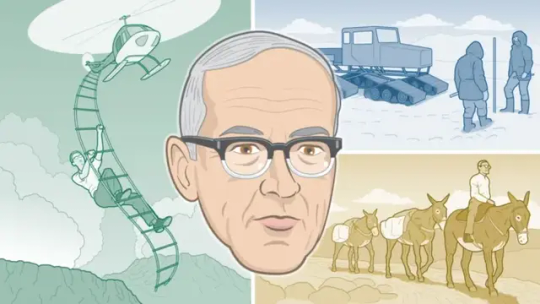
Dr. Clair Patterson, the man who suffered for his accomplishments.
Due to his efforts, gasoline was finally banned in the US but people still suffer through its consequences. But why did it take so long and such hardships to ban leaded gasoline?
The main reason is that lead poisoning is very subtle until the very end. When lead enters the bloodstream the RBCs confuse it with other minerals that the cells actually need that are zinc, iron, etc.. Since lead mimics other viral minerals so well cells absorb them and this began their dance of death. Slowly they self-destruct and since there is no communication the brain fails to understand what is happening with the body as lead blocks neurotransmitters amongst the cells.
Perhaps I will explain more about Dr. Patterson's journey to ban leaded gasoline in a later post.
Now we are finally at
Deadly Invention #2
CFCs or chlorofluorocarbons
It was an age-old problem, i.e. to actually reverse the effect of heat on food items and to actually make a machine that emitted cold instead of warmth. which was when Midgley had another stroke of genius; CFCs.
Before the invention of CFC, companies used coolants such as ammonia, sulfur dioxide, and methyl chloride. But ammonia was notorious after the disastrous catastrophe in an ice manufacturing plant that got destroyed because ammonia in that building caught on fire. sulphur dioxide and methyl chloride on the other hand were toxic gases and caused deaths all around the country.
The situation genuinely got so bad that the government almost passed a law that banned the usage of home fridges.
Midgley was once again tasked with another problem to solve. Find a coolant that was actually both safe and effective in its job.
Once again Midgley knew the answer will come from his passion, chemistry. He narrowed down the elements in the periodic table that were gaseous at low temperatures. finally, there was one element that caught his eye; fluorine.
Now, fluorine was highly toxic on its own, however, Midgley was hoping to combine it with another element that will together make a stable compound and render fluorine non-toxic.
In just a few hours, Midgley and his team came up with a compound in which they combine fluorine, chlorine, and carbon. a new class of compounds called chlorofluorocarbons or CFCs.
Kettering finally concluded that this compound was non-toxic, non-flammable, and essentially safe for both humans and animals. He quickly partnered with DuPont to commercially start the sale of this compound in bulk after a successful previous partnership with the company over leaded gasoline. CFC was finally ready for commercial sale under the catchy name 'Freon'.
In 1932, it finally made its debut. The timing was near perfect, 15 more people were killed by methyl chloride leak. Just like leaded gasoline, it was an overnight sensation and by 1939 DuPont sold 8 million fridges.
Soon other companies used this compound to create a new AC cabinet. It was not actually the freon that caused environmental damages but actually when freon was repurposed into a handheld product that will be catastrophic for the environment and whose price we are still paying today.
By the 1970s, freon was used in almost everything, from ACs to hair sprays.
It was around the time when 2 scientists created the aerosol version of freon to be used as an insecticide mist which gave birth to the aerosol industry that one scientist found out the disastrous consequences of CFCs.
Enter James Lovelock, the scientist who found out the environmental effects of freon in a most unexpected way.
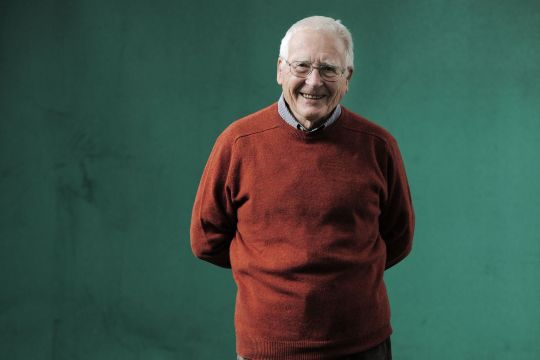
i mean look at that face. so happy and cute. that is the face of the man whose passion and wife is science.
Lovelock actually began this drastic discovery when one day he decided to know whether the haze in front of his house was actually natural mist or chemical compounds from the urban cities. In order to measure this he created a device that will help him accurately measure the synthetic compounds in the air with an accuracy never seen before. In order to measure this, he went on a grand sea voyage from England to Antarctica and just like Dr. Patterson he found out that high concentrations of CFC's emissions were everywhere.
Lovelock presented his findings at a scientific conference in 1976, his findings intrigued 2 chemists who decided to research further on this issue. They found out that unlike other chemicals CFCs had no natural sinks in the earth where they can be naturally dissolved.
Since there were no natural sinks the gas went upwards and accumulated in the upper atmosphere. while roaming in the upper atmosphere the sun's UV rays will ultimately break it down. This chemical reaction will release chlorine from CFCs and thus begins the process of destruction of the ozone layer.
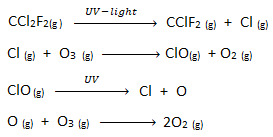
CHEMICAL REACTIONS TO UNDERSTAND BETTER.
Chlorine singlehandedly was responsible for the ozone hole in the atmosphere of Antarctica. this caused an immediate alarm amongst the scientific community because as we all know ozone layer provides a protective layer against the sun's UV rays and prevents us from catching numerous fatal health conditions, most common being skin cancer.
If the emission of CFCs continues at this rate then half of the earth's ozone layer will be gone by 2050. What's more is that in places like DC or Paris, just being outside for 5 minutes will cause severe sunburns. Skin cancer rate will skyrocket and by 2065 plant life will be affected. There will be a decrease in co2 absorption during photosynthesis in plants.
After the Montreal Protocol and international collaboration, CFC was finally banned in 1982. However, the ozone layer destroyed by Midgeley's compound since its use from the 1920s to 1970s is not expected to recover till 2050.
and this is the story of Dr. Thomas Midgely Jr.
next will be perhaps Dr. Clair Patterson.
#history#global warming#global history#science#mad scientist#engineering#lead gasoline#cfc#people#NEED TO LEARN THIS#i need to learn this#today i learned
3 notes
·
View notes
Text
The Age of Healthy Aging: Trends in the Longevity Industry
Redefining Aging: The Dawn of the Longevity Economy
The Longevity Market is a rapidly emerging and transformative sector focused on extending human healthspan—the period of life spent in good health—rather than merely increasing lifespan. This interdisciplinary market encompasses a vast array of products, services, and technologies aimed at preventing, delaying, or reversing age-related diseases and decline. It spans diverse fields, including biotechnology, pharmaceuticals, regenerative medicine, personalized nutrition, preventive healthcare, digital health, age-tech (technology for older adults), and even financial services tailored for extended lives. Driven by an aging global population, scientific breakthroughs in aging biology, and a growing consumer desire for a healthier, more active later life, the longevity market is poised for exponential growth. As of mid-2025, the market is experiencing significant investment and innovation, with projections indicating a global value exceeding USD 63 billion by 2035, growing at a compound annual growth rate of over 10%.

Key Market Drivers and Scientific Frontiers
Several powerful factors are propelling the longevity market forward. The most significant driver is the rapidly aging global population. As the number of individuals aged 60 and above is expected to double by 2050 to surpass 2 billion, there is an immense and growing demand for solutions that enable people to live healthier, more productive lives for longer. This demographic shift is creating vast market opportunities across various sectors, from healthcare to consumer goods and financial services. Furthermore, groundbreaking scientific advancements in aging biology are revolutionizing our understanding of the aging process. Researchers are identifying and targeting the molecular and cellular hallmarks of aging, paving the way for truly transformative interventions.
Scientific and technological innovation is at the core of this market's expansion. Key areas of focus include regenerative medicine, with advancements in stem cell therapy and tissue engineering showing promise in repairing damaged tissues and rejuvenating organs. Senolytics and cellular therapies are emerging as a major frontier, targeting and eliminating senescent (aging) cells that contribute to age-related inflammation and dysfunction. Technologies like CRISPR gene editing offer the potential to correct genetic predispositions to age-related diseases. The increasing adoption of biomarker analysis and preventive genomics is enabling personalized longevity interventions, allowing individuals to understand their biological age and tailor their lifestyle and medical strategies. Artificial intelligence (AI) and machine learning (ML) are playing a pivotal role in accelerating drug discovery, identifying novel therapeutic targets, and personalizing health recommendations based on vast datasets of genetic, metabolic, and lifestyle information. The rise of the "biohacking" and "wellness" movements further fuels consumer demand, with individuals actively seeking dietary supplements, exercise regimens, and digital tools to optimize their health and extend their healthspan. Wearable devices and smart health apps are increasingly becoming integrated components of longevity strategies, providing real-time data on health metrics.
Market Segmentation and Investment Landscape
The longevity market is incredibly diverse and can be segmented by various solutions and services: therapeutic interventions (e.g., senolytics, regenerative medicine, gene therapies), diagnostics (e.g., biological age testing, genetic testing), digital health and wellness platforms (e.g., health tracking apps, personalized nutrition advice), financial services (e.g., retirement planning for extended lifespans, long-term care insurance), and age-friendly products and services (e.g., smart home technologies, accessible travel).
Geographically, North America, particularly the US, dominates the longevity market due to its robust venture capital ecosystem, cutting-edge research institutions, and a large consumer base focused on health optimization. Europe, with countries like the UK, Germany, and Switzerland, is also fostering a growing number of longevity startups and research centers. The Asia-Pacific region, especially Japan, South Korea, and Singapore, is investing heavily in longevity R&D, driven by some of the world's oldest populations. Challenges for the market include the significant R&D costs, the complex regulatory pathways for novel anti-aging therapies, and ethical considerations surrounding life extension. Despite these challenges, the unprecedented confluence of demographic trends, scientific breakthroughs, and burgeoning investment ensures that the longevity market will continue its rapid expansion, fundamentally reshaping healthcare, economies, and how humanity perceives and experiences aging.
About Market Research Future (MRFR) Market Research Future (MRFR) is a global market research firm that provides comprehensive insights into market trends, drivers, challenges, and opportunities. We offer a broad range of market intelligence reports and consulting services to help businesses and enterprises in various industries make informed decisions
Media Contact: Market Research Future (MRFR) Phone: +1-646-845-9312 Email: [email protected] Website: marketresearchfuture
0 notes
Text
Introduction to 5V Ultra-Low Capacitance ESD Protection Diodes with Snapback in DFN1006 and DFN0603 Packages Shanghai Leiditech has launched two 5V
Shanghai Leiditech has launched two 5V ESD protection diodes with small packages (DFN1006 and DFN0603) and snapback characteristics, offering low clamping voltage (VCmax): ULC0521CLV and ULC0542CLV.
The following diagram illustrates the electrical parameters of standard ESD and snapback ESD diodes.
As we can see, for ordinary ESD (Electrostatic Discharge) protection devices, the clamping voltage (VC) gradually increases with the rise of peak pulse current (IPP). In contrast, snapback ESD devices exhibit a voltage reversal after breakdown: VC drops to a lower baseline first and then rises slowly. Therefore, the VC of snapback ESD diodes is significantly lower than that of ordinary ESD diodes. For specific parameter comparisons, please refer to the table below.
Parameter Definitions
VRWM : The maximum reverse voltage the TVS diode can withstand without conduction.
VBR: The voltage at which ESD protection activates, typically measured at 1 mA test current.
VC : The voltage clamped by the TVS diode during ESD events.
VCmax@A: Clamping voltage at peak pulse current (IPP) under 8/20μs waveform.
Cj : Parasitic capacitance in the TVS diode, affecting signal integrity.
For the two snapback models ULC0521CLV and ULC0542CLV in the upper rows of the table, the clamping voltage (VC) is 8V at an IPP of 6A.
For the two standard ESD diodes in the lower part, the clamping voltage (VC) is 25V at an IPP of 4A or 5A, which is much higher than that of the snapback types.
For the integrated circuits (ICs) to be protected, a lower clamping voltage of the ESD diode provides better protection for the IC and enhances its electrostatic resistance. Therefore, design engineers prefer to select snapback-type ESD diodes.
With ultra-low capacitance and low VC, ULC0521CLV and ULC0542CLV are ideal choices for ESD protection of high-speed signals, such as USB 3.0, RF signals, etc.
Leiditech Electronics is committed to becoming a leading brand in electromagnetic compatibility (EMC) solutions and component supply. We offer a wide range of products, including ESD, TVS, TSS, GDT, MOV, MOSFET, Zener diodes, and inductors. With an experienced R&D team, we provide personalized customization services to deliver the highest quality EMC solutions tailored to our customers' needs.
contact Doreen [email protected]
【Contact】 Doreen Xu
【Company】 Shanghai Leiditech Electronic Technology Co., Ltd.
【Sales Company】 HongKong Leiditech Technology Co., Ltd.
【Mobile Phone | Wechat】+86–18616228909
【Tel.】+86–21 50828806
【Email】[email protected]
【Web】en.leiditech.com
【Web search】leiditech
【Address】2nd Floor, Building A, №518 Kangshan Road,
Kangqiao Town, Pudong New District, Shanghai, China 201315
【Advantage】Our Products have been certified by Rohs,Reach, ISO9001
Products comply with IEC61000–4–2, ISO10605, 16949, ISO763–2, ISO17650–2, GB21437–2 standard.
Reliable quality, Reasonable price, Delivery fast.
【Supply】 ESD/TVS/GDT /TSS/SKY/MOS/DIODES/MOV
0 notes
Text
Why Gary Brecka Biologist Is the Secret to 10x Health, Longevity, and Performance

In today’s fast-paced world, where chronic fatigue, stress, and preventable diseases are becoming more common, people are searching for personalized health solutions. Enter Gary Brecka, a renowned expert whose groundbreaking methods are transforming lives by decoding the human body at a cellular level.
With a science-based approach and a passion for helping others thrive, Gary Brecka Biologist isn’t just changing lives—he’s redefining the future of health. Through his proprietary strategies, especially the game-changing Gary Brecka 10x method, he’s empowering people to unlock their full physical and mental potential.
Who Is Gary Brecka?
Before becoming a household name in wellness circles, Gary Brecka worked as a mortality expert in the life insurance industry. His job was to predict how long individuals had to live, using algorithms and medical data. But the realization that lives could be extended and improved with timely intervention led him on a new path.
Now, as a human biologist and health optimization expert, Gary Brecka Biologist is using that same data-driven mindset to reverse engineer illness and promote vitality. He focuses on analyzing DNA, blood biomarkers, and lifestyle factors to create customized health protocols for everyone—from everyday individuals to elite athletes and celebrities.
The Science Behind Gary Brecka 10x
At the core of Brecka’s philosophy lies the Gary Brecka 10x method—a comprehensive health optimization protocol designed to maximize energy, mental clarity, and longevity.
But what does “10x” really mean in this context?
It’s about multiplying your body’s performance, not just by marginal increments but exponentially. It includes:
DNA testing for genetic predispositions
Nutrient optimization through blood biomarker analysis
Methylation support for better detox and energy production
Hormone balancing
Anti-aging strategies using natural protocols
What makes the Gary Brecka 10x approach so effective is that it's tailored. No more generic advice—only personalized action plans that target your body’s specific needs.
Why DNA Holds the Key to Your Health
One of the most revolutionary parts of Gary Brecka’s method is his focus on DNA analysis. By looking at your genetic blueprint, Gary Brecka Biologist identifies how your body processes nutrients, detoxifies, repairs cells, and even manages stress.
For instance, if your DNA reveals that your body doesn’t methylate properly, it can lead to reduced energy, poor detoxification, and even mental fog. Brecka’s solutions involve correcting these imbalances with specific supplements, lifestyle changes, and medical-grade protocols—often with profound results.
This level of personalization ensures you’re not just surviving, but thriving.
Gary Brecka Reviews: What Are People Saying?
The real proof of any method lies in the results—and the Gary Brecka Reviews are overwhelmingly positive.
From world-class athletes to entrepreneurs and everyday families, clients are raving about life-changing transformations:
Increased energy levels within days
Weight loss and improved metabolism
Sharpened mental focus
Better sleep and reduced anxiety
Reversal of chronic symptoms that mainstream medicine couldn’t fix
These Gary Brecka Reviews aren’t just testimonials—they’re stories of hope, resilience, and empowerment.
One client reported, “After following Gary’s protocol, I felt like a new person. I finally understood what my body needed, and the results were immediate.”
The Power of Data-Driven Wellness
What sets Gary Brecka Biologist apart is his fusion of hard science with holistic wellness. While many health influencers rely on trends, Brecka uses decades of data, clinical research, and biological insight to craft each health plan.
His belief is simple: If you can measure it, you can fix it.
He often says that our bodies aren’t broken—they’re just misinformed. By decoding the biological messages hidden in our DNA and blood, he gives us the map to optimal health.
This scientific edge is why the Gary Brecka 10x method is gaining rapid popularity among those who are serious about transforming their lives.
Gary Brecka Cardone Venture: A Bold Collaboration
When two powerhouses join forces, great things happen. The Gary Brecka Cardone Venture is a partnership between Brecka and business mogul Grant Cardone, aimed at scaling personalized wellness to the masses.
This collaboration has enabled Brecka’s protocols to reach a wider audience through education, events, and tech-powered health platforms. Together, they’ve launched wellness programs that combine mindset, biology, and performance strategies into one cohesive experience.
Whether it’s corporate health initiatives or personal transformation seminars, the Gary Brecka Cardone Venture is committed to empowering people to live longer, stronger, and smarter.
Beyond Biohacking: A New Era of Human Optimization
While many categorize Brecka’s work under the buzzword “biohacking,” his philosophy runs deeper. It’s not just about hacking the body—it’s about understanding it.
Gary Brecka Biologist encourages people to move away from guesswork and into self-mastery. Instead of relying on trends, his method is rooted in:
Evidence-based science
Biological individuality
Sustainable wellness
From optimizing the nervous system to supporting mitochondrial function, the Brecka blueprint is built on fundamentals that stand the test of time.
Your Journey to 10x Health Starts Here
It’s never been easier to begin your wellness transformation. Whether you’re dealing with fatigue, brain fog, mood swings, or simply want to feel your best again, Gary Brecka offers the tools and guidance to make that a reality.
Steps to start:
Get your DNA and blood tests done
Receive a customized health report
Follow your protocol with expert guidance
Track progress and optimize continuously
Thousands have already taken the leap—and the reviews speak for themselves. The message is clear: Your health is in your hands, and the right information can change everything.
Why It Matters Now More Than Ever
With rising rates of chronic disease, burnout, and preventable illnesses, the need for personalized health solutions has never been greater. Gary Brecka Biologist isn’t just offering a service—he’s starting a movement.
He reminds us that true wellness is not about managing symptoms, but addressing root causes.
And in a world that often feels reactive and impersonal, Brecka’s work is refreshingly proactive, human-centered, and deeply impactful.
Conclusion: The Future of Health Is Personal
If you’ve ever wondered whether it’s possible to feel energized, focused, and truly alive again—the answer is yes. And the blueprint may just lie in your DNA.
Gary Brecka, through his innovative methods and passion for healing, is proving that health isn’t one-size-fits-all. With the Gary Brecka 10x system, personalized testing, and a mission-driven mindset, he’s setting a new standard for what’s possible.
And as the momentum continues with the Gary Brecka Cardone Venture, one thing is clear: This is only the beginning.
Are you ready to become the healthiest version of yourself?
0 notes